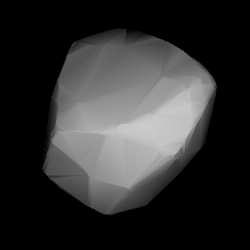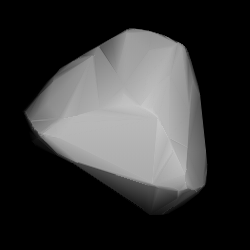Related Research Articles
515 Athalia, provisional designation 1903 ME, is a carbonaceous Themistian asteroid from the outer regions of the asteroid belt, approximately 40 kilometers in diameter. It was discovered on 20 September 1903, by German astronomer Max Wolf at the Heidelberg Observatory in southwest Germany. The asteroid was named after the ancient Judahite queen Athaliah.
Pawlowia, provisional designation 1923 OX, is a background asteroid from the central regions of the asteroid belt, approximately 20 kilometers in diameter. It was discovered on 5 October 1923, by Soviet astronomer Vladimir Albitsky at the Simeiz Observatory on the Crimean peninsula. The asteroid was named after Russian physiologist and Nobelist Ivan Pavlov.
La Paz, provisional designation 1923 PD, is a carbonaceous asteroid from the outer region of the asteroid belt, approximately 40 kilometers in diameter. It was discovered on 31 October 1923, by German astronomer Max Wolf at the Heidelberg-Königstuhl State Observatory and named after the city La Paz in Bolivia.

1032 Pafuri, provisional designation 1924 SA, is a dark background asteroid from the outer regions of the asteroid belt, approximately 65 kilometers in diameter. It was discovered on 30 May 1924, by English astronomer Harry Edwin Wood at the Union Observatory in Johannesburg, South Africa. The asteroid was named for the river in the Pafuri Triangle in South Africa, created by the confluence of the Limpopo and Levubu rivers. The body's spectral type and rotation period are still poorly determined.

1132 Hollandia, provisional designation 1929 RB1, is a stony asteroid from the middle region of the asteroid belt, approximately 27 kilometers in diameter. It was discovered on 13 September 1929, by Dutch astronomer Hendrik van Gent at Leiden Southern Station, annex to the Johannesburg Observatory in South Africa. It was named for the region Holland in the Netherlands.
1712 Angola, provisional designation 1935 KC, is a dark asteroid from the outer regions of the asteroid belt, approximately 66 kilometers in diameter. It was discovered on 28 May 1935, by English-born South African astronomer Cyril Jackson at Johannesburg Observatory in South Africa. It is named after the Republic of Angola.

1457 Ankara, provisional designation 1937 PA, is a stony asteroid from the central region of the asteroid belt, approximately 18 kilometers in diameter. It was discovered on 3 August 1937, by German astronomer Karl Reinmuth at Heidelberg Observatory in southwest Germany, and later named for the Turkish capital city of Ankara.
1354 Botha, provisional designation 1935 GK, is an exceptionally dark background asteroid from the outer regions of the asteroid belt, approximately 46 kilometers in diameter. It was discovered on 3 April 1935, by South-African astronomer Cyril Jackson at the Union Observatory in Johannesburg. The asteroid was named after South African prime minister Louis Botha.
1295 Deflotte, provisional designation 1933 WD, is a carbonaceous asteroid from the outer regions of the asteroid belt, approximately 48 kilometers in diameter. It was discovered on 25 November 1933, by French astronomer Louis Boyer at the Algiers Observatory in Algeria, North Africa. The asteroid was named after the discoverer's nephew.
1319 Disa, provisional designation 1934 FO, is a carbonaceous asteroid from the outer region of the asteroid belt, approximately 25 kilometers in diameter. It was discovered on 19 March 1934, by English-born, South African astronomer Cyril Jackson at Johannesburg Observatory in South Africa. It is named for the orchid Disa.
1541 Estonia, provisional designation 1939 CK, is an asteroid from the central regions of the asteroid belt, approximately 21 kilometers in diameter. It was discovered on 12 February 1939, by astronomer Yrjö Väisälä at the Iso-Heikkilä Observatory near Turku, Finland. The asteroid was named after the Baltic country of Estonia.
1308 Halleria, provisional designation 1931 EB, is a carbonaceous Charis asteroid from the outer regions of the asteroid belt, approximately 43 kilometers in diameter. It was discovered on 12 March 1931, by German astronomer Karl Reinmuth at the Heidelberg-Königstuhl State Observatory. The asteroid was named after Albrecht von Haller a Swiss physician, botanist and poet.
2016 Heinemann, provisional designation 1938 SE, is a carbonaceous Themistian asteroid from the outer regions of the asteroid belt, approximately 22 kilometers in diameter. It was discovered on 18 September 1938, by German astronomer Alfred Bohrmann at Heidelberg Observatory in southwest Germany, and later named after ARI-astronomer Karl Heinemann (1898–1970).
1939 Loretta, provisional designation 1974 UC, is a carbonaceous Themistian asteroid from the outer region of the asteroid belt, approximately 30 kilometers in diameter. It was discovered on 17 October 1974, by American astronomer Charles Kowal at Palomar Observatory in California, who named it after his daughter, Loretta Kowal. The discovery of the asteroid took place during Kowal's follow-up observations of Jupiter's moon Leda, which he had discovered one month prior.

1356 Nyanza, provisional designation 1935 JH, is a dark asteroid from the background population of the outer asteroid belt, approximately 63 kilometers in diameter. It was discovered on 3 May 1935, by South-African astronomer Cyril Jackson at the Union Observatory in Johannesburg. The asteroid was named for the former Nyanza Province in Kenya, Africa.
2043 Ortutay, provisional designation 1936 TH, is a dark asteroid from the outer regions of the asteroid belt, approximately 45 kilometers in diameter. The asteroid was discovered by Hungarian astronomer György Kulin at the Konkoly Observatory, Budapest, on 12 November 1936. It was named after Hungarian ethnographer Gyula Ortutay.
1760 Sandra, provisional designation 1950 GB, is a carbonaceous asteroid from the outer regions of the asteroid belt, approximately 35 kilometers in diameter. It was discovered on 10 April 1950, by South African astronomer Ernest Johnson at Union Observatory in Johannesburg, and named after his granddaughter Sandra.
1397 Umtata, provisional designation 1936 PG, is an asteroid from the background population of the asteroid belt's central region, approximately 21 kilometers in diameter. It was discovered by South-African astronomer Cyril Jackson at the Union Observatory in Johannesburg on 9 August 1936. The asteroid was named after the South-African town of Mthatha, formerly known as Umtata.
1302 Werra, provisional designation 1924 SV, is a Themistian asteroid from the outer regions of the asteroid belt, approximately 30 kilometers in diameter. It was discovered on 28 September 1924, by German astronomer Karl Reinmuth at the Heidelberg-Königstuhl State Observatory. The asteroid was named for the river Werra in central Germany.
1466 Mündleria, provisional designation 1938 KA, is a carbonaceous asteroid from the inner regions of the asteroid belt, approximately 22 kilometers in diameter.
References
- 1 2 3 4 "JPL Small-Body Database Browser: 1731 Smuts (1948 PH)" (2016-12-25 last obs.). Jet Propulsion Laboratory . Retrieved 7 June 2017.
- 1 2 3 4 Schmadel, Lutz D. (2007). "(1731) Smuts". Dictionary of Minor Planet Names – (1731) Smuts. Springer Berlin Heidelberg. p. 137. doi:10.1007/978-3-540-29925-7_1732. ISBN 978-3-540-00238-3.
- 1 2 3 4 5 6 7 "LCDB Data for (1731) Smuts". Asteroid Lightcurve Database (LCDB). Retrieved 21 December 2016.
- 1 2 3 4 Usui, Fumihiko; Kuroda, Daisuke; Müller, Thomas G.; Hasegawa, Sunao; Ishiguro, Masateru; Ootsubo, Takafumi; et al. (October 2011). "Asteroid Catalog Using Akari: AKARI/IRC Mid-Infrared Asteroid Survey". Publications of the Astronomical Society of Japan. 63 (5): 1117–1138. Bibcode:2011PASJ...63.1117U. doi: 10.1093/pasj/63.5.1117 . (online, AcuA catalog p. 153)
- 1 2 3 Masiero, Joseph R.; Grav, T.; Mainzer, A. K.; Nugent, C. R.; Bauer, J. M.; Stevenson, R.; et al. (August 2014). "Main-belt Asteroids with WISE/NEOWISE: Near-infrared Albedos". The Astrophysical Journal. 791 (2): 11. arXiv: 1406.6645 . Bibcode:2014ApJ...791..121M. doi:10.1088/0004-637X/791/2/121.
- 1 2 3 4 Mainzer, A.; Grav, T.; Masiero, J.; Hand, E.; Bauer, J.; Tholen, D.; et al. (November 2011). "NEOWISE Studies of Spectrophotometrically Classified Asteroids: Preliminary Results". The Astrophysical Journal. 741 (2): 25. arXiv: 1109.6407 . Bibcode:2011ApJ...741...90M. doi:10.1088/0004-637X/741/2/90.
- 1 2 Behrend, Raoul. "Asteroids and comets rotation curves – (1731) Smuts". Geneva Observatory . Retrieved 21 December 2016.
- 1 2 "1731 Smuts (1948 PH)". Minor Planet Center. Retrieved 21 December 2016.
- ↑ Schmadel, Lutz D. "Appendix – Publication Dates of the MPCs". Dictionary of Minor Planet Names – Addendum to Fifth Edition (2006–2008). Springer Berlin Heidelberg. p. 221. doi:10.1007/978-3-642-01965-4. ISBN 978-3-642-01964-7.